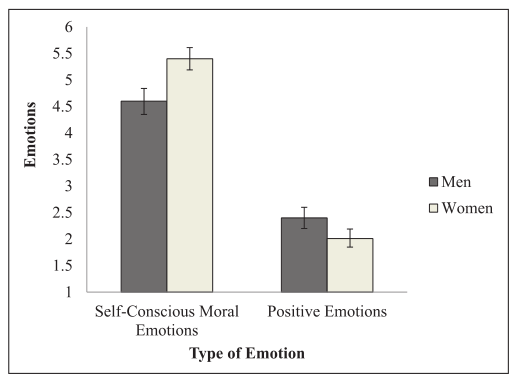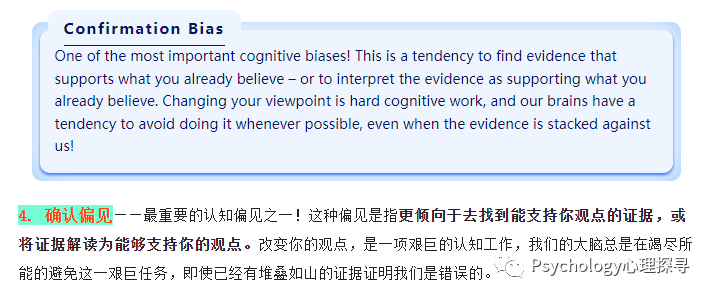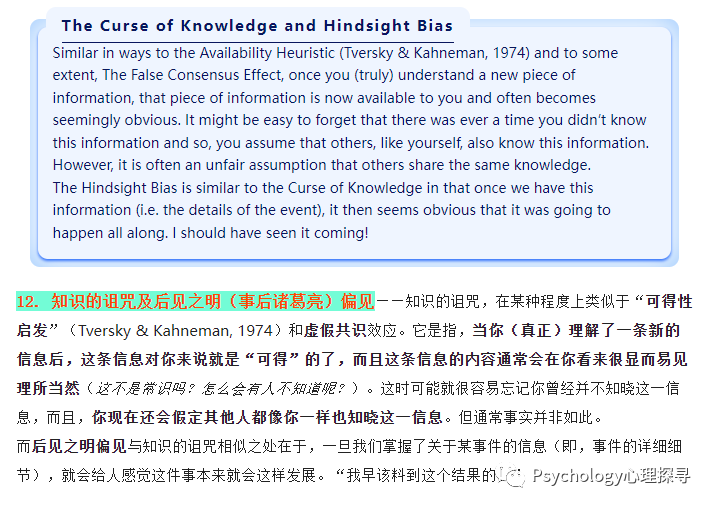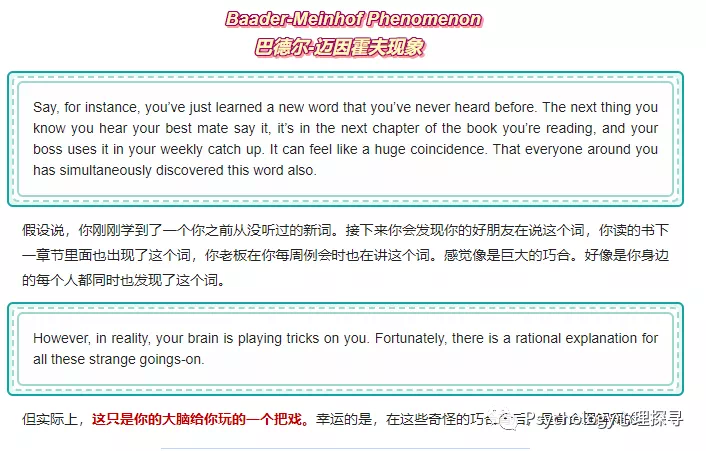Seeing the “bigger picture” is a slang term used to describe widening your perspective to get a clearer view of what really matters, and what doesn’t.
有“大局”观,是指扩大自己的视角范围,让自己更清晰辨别重要和非重要事项。
Because seeing the bigger picture is all about perspective, it’s subjective by nature and less of an exact science. Never-the-less, there are scientific principles that can boost your ability to see the bigger picture.
由于所谓的大局观,是一种观点,因此其本质上是主观的,而非一种严谨的科学。但在提升大局观能力上,却的确存在科学的准则。
In order to fully see the ‘bigger picture’ it’s vital to take onto account as many perspectives as possible in order to gain a deeper understanding for all sides of the truth.
为全面看到大局,需要尽可能考虑到更多的视角,从而能够更深入了解真相的所有方面。
Increasing your ability to see the ‘Bigger Picture’ increases self-awareness, can give you more control over your life, more control over your emotions, actions, behavior, and with increased awareness comes a sense of calmness which reduces daily anxiety.
提升个人的“大局观”能力,个人的自我觉察能力(自知力)也能够相应提升,从而自己能够更好掌控人生,更好地控制个人情绪、举措、行为。而且,随着个人觉察力地提升,随之而来地是一种宁静感,这种宁静感可以降低日常焦虑。
Understanding the “Bigger Picture”
了解“大局”
Big picture thinking is a broadening of your perspective by looking at the wholeness of all context in any given situation.
大局思维,是指拓宽个人视角,拓宽方式是:在任何既定条件下,看到全面整体背景。
In a 2018 study, published by Ohio State university, psychology experts define someone who has a “big picture” perspective as an individual with a “high-level construal”. Construal, meaning understanding.
在2018年俄亥俄州立大学发布的一项研究中,心理学专家将拥有“大局观”之人定义为:“具备高级解释水平的个体。”这里的“解释水平”,即理解力之意。
In a clear definition of big picture thinking, according to ScienceDaily, “High-level construal allows you to step back and see the consequences of your decision and to see more clearly the best way to allocate resources,”
根据 ScienceDaily对大局思维所作出的明确定义,“拥有高解释水平,可以让你后退一步,看到自己决策的后果,更清晰看到如何以最佳方式分配资源。”
One of the leaders of the study, Dr. Paul Stillman, says that seeing the “bigger picture” is fostered by creating mental and emotional distance from the decision. Being subjective and open minded to the possibility that you could be wrong.
该研究的领导人物之一 Paul Stillman博士表示:看到“大局”,这一能力的养成方式是:与决策之间保持精神和情绪上的距离。接受“自己可能是错的”这一可能性。
In the study, Stillman and his colleagues found that people tended to make the most efficient decisions, with the most overall value, when they looked at the bigger picture. In other words, the best decision makers were able to see ‘the forest through the trees’.
在本研究中,Stillman和其同事们发现当人们眼观大局时,他们往往会达成最高效的、整体价值最高的决策。换言之,最佳决策者不会被一叶障目。
Since scientific evidence has proven that ego’s warp our sense of reality, It’s also important to set your ego aside when looking at the bigger picture as you do not want to filter your bigger picture perspective through your ego.
鉴于科学证据已经表明,我们的ego(自我)能够扭曲我们对现实的认知,因此当试图看到大局时,需要摆脱自己的ego,因为你不需要通过你的ego滤镜来审视全局。
How Big, Is The Bigger Picture
当我们说大局时,是指多大呢?

The Universe And Our Place With-In it
宇宙和我们在其中所处位置
Understanding the bigger picture, is all about understanding context.
了解大局,本质上在于了解事物背景。
With-in the context of the United States in the year 1800, the presidential election of 1800 seemed massively important. However, looking at the Bigger Picture 200 years later, you’ll be hard pressed to find anyone who thinks the election of 1800 was a big deal at all.
在1800年美国这一时空背景下,1800年的总统选举似乎极其重要。但如果在200年之后的背景下来看,则很难找到任何觉得1800年选举是件大事之人。
Within the context of the entire cosmos and infinite universe, nothing our human civilization is currently doing matters.
在整个无尽浩瀚宇宙背景下来看的话,整个人类文明当前在做的事情都毫无意义。
According to Dr. Sean Carroll, a theoretical physicist at the California Institute of Technology, there is much that we don’t know about the universe, but there is also much that we do know. The universe is large, and we are small.
根据加州理工学院理论物理学家 Sean Carroll博士的观点,我们对宇宙不了解之处还有很多,但我们了解的也不少。宇宙很大,我们很小。
He says , “Our lives are short against the span of cosmic history”, but the fact that we contemplate and care about the people and environment around us brings meaning to our existence.
他说:从浩瀚宇宙历史来看,人生如白驹过隙。但我们守望相助,关爱环境,这就为我们的存在带来了意义。
Dr. carroll believes that humans, as higher-level creatures, have the ability to construct purpose for ourselves.
Carroll博士相信,人类作为更高级生物,有能力为其自身构建使命感。
So how big is the bigger picture?
“大局”究竟有多大呢?
It’s as big as we want it to be. When looking for big picture solutions to life or a big picture understanding to work problems, there’s always a higher level of contextual understanding that can explored for a deeper and longer term perspective.
这取决于我们想让它有多大。当希望着眼于大局为人生问题寻找解决方案,或希望从大局视角理解工作中的问题时,我们总是可以将这些问题放在更宏观全面的背景中去审视,从而获得更深刻、更长期化的视角。
Are You A Big Picture Thinker Or A Detailed Thinker?
你是大局思维者还是细节思维者?
Big picture thinking is a skill than anyone can develop, but like any skill, some people are naturally geared towards big picture thinking, and some people are naturally geared toward detail oriented thinking.
Without detailed oriented thinking, big picture thinkers would never have their visions come to reality. And without big picture thinking, detailed oriented thinkers may end up lost in the weeds. it take a balance of both types of thinking to optimize value.
大局思维是任何人都可以培养的技能,但同其他任何技能一样,一些人天生比较倾向于大局思维,而一些人则天生倾向于细节思维。
没有细节思维的话,大局思维者的愿景永远都不会实现,而没有大局思维,细节思维者则会被乱花渐欲迷人眼。想要获得最优解,需要在两种思维之间找到平衡。

Characteristics of Big Picture Thinking
大局思维特征:
You quickly notice patterns in problems.
You have a low tolerance for routine details, tedious errands, and busywork.
You are great at outlining goals for what needs to be done. But you get tired quickly when you start getting into the smaller more tedious details that need to be done to achieve the goals.
Most people find big picture thinkers creative and innovative.
能够很快意识到问题的规律。
对常规细节和繁琐任务等容忍度较低。
擅长为所需完成的任务规划整体目标,但当开始着手于为实现这些目标而必须完成的繁琐细节时,你开始很快感到厌倦。
大多数人发现大局思维者充满创造力和创新力。
Characteristics of a Detail-Oriented Thinker
细节思维的特征
You tend to dwell on the ins and outs of a project’s specifics.
You enjoy optimizing the inner workings of something that already exists instead of starting from scratch and creating something new.
You are analytical.
You tend not to like change and can becomes frustrated if things change too much or with-out proper notice.
You fear failure and not doing things the right way.
你往往会沉溺于一个项目的具体细节。
你喜欢优化某一已存在事物的内在工作原理,而非从头开始创造一个新事物。
你善于分析。
你不喜欢变化。如果事情变化太大或者没有合理提前通知,你会感到很受挫。
你害怕失败,害怕犯错。
How To See The Big Picture?
如何看到大局?
To see the big picture you need as much information to inform your opinion as you can gather.To gather a better understanding for truth you need data. And the best way to get data, is to understand as many perspective‘s as possible.
想要看到大局,你需要尽可能获得更多的信息。想要更好地理解真相,你需要数据。而获得数据的最佳方法,就是尽可能理解更多的视角。
What problems are you facing? What is the root cause of those problems? How do you know for sure that you’re right?What are the best solutions? Have you looked at everything from all perspective to make sure you have the best solution.
你当前面临的问题是什么?这些问题的根本原因是什么?你如何确信你是正确的?
最佳解决方案是什么?你是否已经从各个视角全盘审视以确保你当前做出的是最佳解决方案呢?
Are you thinking big enough?
Is your perspective being overshadowed by your ego or a bigger yet perspective that you’re not seeing?
These are the types of questions we need to be asking ourselves when looking at the bigger picture.
你的思维是否足够宏观?
你的视角是否被你的ego所蒙蔽?或者是否还有一种更宏观的视角你并没有看到?
这些都是当你试图眼观大局时需要自问的问题。

Tips To Help You See the “Big Picture” With Clarity
如何清晰看到“大局”
- Avoid Getting “Caught Up In The Weeds
“避免被乱花迷眼
The first step in becoming a big picture thinker is to break the habits that prevent us from zooming out. If you’re detail-oriented, you tend to look for perfection.
成为大局思考者的第一步,是打破避免我们着眼大局的那些习惯。如果你是细节型思考者,你往往会追求完美。
Research shows that too much attention to detail in the early stages of a project can actually promote failure. If you’re constantly fixing and changing things from day dot, you may end up giving up or scrapping the project completely.
研究显示,在项目早期阶段过多关注细节实际上可能会增加失败风险。如果从一开始就不断修补更改,最终可能会彻底放弃或取消这一项目。
Focus on the end goal and constantly remind yourself of it. When you think you’re spending too much time on the wider picture, remember what it is you are striving for. This will help to remind you what you need to do and keep you from jumping down the detail rabbit hole.
聚焦最终目标,不断提醒自己着眼于最终目标。当你觉得你在”大局“上面花费了过多时间时,记住自己在追求的最终目标。这会提醒你所需完成的任务,并避免你坠入细节之无底洞。
Work as a team and delegate certain tasks to also help to move the project forward. With several people working towards the same goal, you can get the same level of high-quality work without sacrificing deadlines.
与团队一起工作,适当放权,也可以有助于推进项目。几个人一起朝着共同的目标前进,这样工作质量并不会降低,而且也会按时完成。
When you see the bigger picture in life you begin to understand where you are heading. At this point you can strategize and refocus your attention on your future goals and timelines instead of focusing on minor obstacles.
当你能够着眼大局,你开始明白自己前进的方向。这时候,就可以策略化调整注意力,将其重新聚焦于未来目标和时间线上,而非被小障碍一叶障目。
Both big picture thinking and detail-oriented thinking is important in life. And, it is possible (and necessary) to do both. But don’t get caught up in the weeds for too long.
大局思维和细节思维在人生中同样重要。是可以,也需要兼顾二者。不要花太多时间沉溺细节之中。
- Ask Lots of Questions to Maximize Understanding
询问大量问题,以尽可能获得全面理解。
Big picture thinkers do not dwell on the minute details. But that doesn’t mean they don’t ask questions about minute details. According to Harvard professor Leslie K. John, who specializes in negotiation, asking questions is a uniquely powerful tool for unlocking value and naturally improving our emotional intelligence.
大局思维者不会耽于细枝末节的细节之中。但这并不意味着他们不会询问关于细节的问题。按照专业研究谈判领域的哈佛教授 Leslie K. John所说,询问问题是解锁价值、自然提升情商的独特强大工具。
Asking questions is not a sign of weakness, but a sign of curiosity and intelligence. In order to get a complete understanding from all perspectives, asking questions is important to gain relevant context for deepening our understanding of the bigger picture.
询问问题,并不意味着软弱,而是意味着好奇心和智力。为从所有视角全面了解事物,询问问题是非常重要的,因为它可以让人了解相关背景,从而深化人们对大局的理解。
In his book, The Magic of Big Thinking, Ph.D. author, David Schwartz, reminds us to “see what can be, not just what is.” Asking yourself certain big thinking questions can help you become more optimistic in terms of what you can achieve.
在David Schwartz博士的著作《The Magic of Big Thinking》中,他提醒我们要“看到可能,而非只是现状。”询问自己一些大局思维问题可以有助于我们更乐观看待个人潜力。
Some questions include:
一些问题包括:
What am I trying to achieve?
我正努力实现的目标是什么?
What are the intended consequences?
我想要实现怎样的结果?
Who might this be good for that I hadn’t thought of?
有哪些我之前并没想到的潜在受益者?
Who am I actually doing this for?
我实际上在为谁做这一切?
Could this start a new trend?
这是否会引领一个新的趋势?
Could I build on this work in the future?
这是否会成为未来某种发展的基础?
Could I collaborate with others on this?
我是否可以和别人在这件事上合作?
In what way is this different from what is already out there?
这与当前已经存在的产品/事物相比有何不同?
Are there any ethical questions surrounding this work?
关于这项工作是否存在道德争议?
Are there any social groups this could affect more than others?
是否有某些社会团体对这项工作会产生更大的影响?
Are there any unintended consequences?
是否会产生意外后果?
- See The Details, But With-in The Context Of The Bigger Picture
看到细节,但将其放在大局背景下审视
Of course details are important but you need to see them with-in the correct context.
If you were to only look at the artwork above up-close, then you would just see a bunch of screws. But when you zoom out and see the screws in the full context, all the screws make up a face.
当然,细节也很重要,但需要将其置于正确背景之中。

如果对上面的作品近距离看,那么你只能看到一些螺钉,但如果将其放在整体背景下,你会看到所有螺钉组成了一张脸的图案。
Don’t get lost in the chaos of details with-out big picture context.
Seeing the “big picture” in life allows us to focus on that aspect of life that matters the most without being distracted by inconsequential details.
不要在无大局背景的条件下迷失在无序细节之中。
在生活中,看到大局,让我们能够专注于生活中最重要的事项,而非迷失于鸡毛蒜皮琐碎细节之中。
- Don’t Dwell on Problems, Maintain a Clear Vision of Your Big Picture Goals and Focus on Solutions
不要沉溺于问题,始终清晰看到你的大局目标,聚焦于解决方案
Big picture visionary’s like Steve Jobs, Elon Musk, and George Washington back in the day, all have dealt with their share of problems. but for every problem they face, they maintain focused on the bigger picture goal and invent solutions to get them there. When seeing the bigger picture you become very fast at solving problems.
一些具有大局视野的高瞻远瞩者,如史蒂夫·乔布斯,埃隆·马斯克和乔治·华盛顿都曾面临种种问题,但对于他们遇到的每个问题,他们都会始终着眼于大局目标,并想出解决方案来帮助他们达成这些目标。当着眼大局时,你能够很快解决问题。
- Look up!向上看!
Physically moving our heads can spark different kinds of thinking. When we focus too much on the detail, we tend to look down, often at the thing we are trying to focus on.
Experts recommend that looking up can inspire big picture thinking. By looking up, we stimulate our brain to begin inductive reasoning, allowing us to be more creative.
We then start to become more abstract in our logical connections which can encourage new thoughts and ideas to add to a project.
移动头部,可以激发不同思维方式。当我们过度沉溺于细节时,我们往往会埋头于这些细节工作之中。专家建议,向上看这个动作可以激发大局思维。通过向上看,我们刺激大脑开始进行归纳推理,让我们更有创造力。
然后,我们就会在逻辑联系中更抽象化,这会有助于新想法和创意的产生。
- Map out your entire project
为整个项目创建路线图
If you have trouble looking at the bigger picture, a helpful strategy is to map out exactly what it is you’re trying to achieve, and how. Not only does this improve time management and allow you to create achievable goals to track progress, but it also reminds you of what you’re working towards.
Keep your project map within eyesight and look at it a few times a day to stay on track and limit the focus on minor details.
如果你很难看到大局,那么一个有效的方法就是围绕自己的目标和实现方式创建一个路线图。这不仅可以提升时间管理,而且还会让你创建一个个可达成的细分目标,从而追踪整体进展,同时还会提醒你最终目标是什么。
让这一项目路线图始终在视野之内,每天看数次,确保一切按计划进行,并限制自己耗费在细枝末节事项上的精力。
- Start a journal
记日记
If you’re looking to become better at big picture thinking in general, training your brain is key. Journaling gives your brain time to process your thoughts as you go, which can inspire new ideas or connect concepts you’d never thought about before.
如果你想整体提升自己的大局思维能力,训练自己的大脑至为关键。通过记日记,可以给大脑时间来处理思绪,这可能会激发新想法,或将不同概念以新的方式联系在一起。
Final Thoughts: Seeing The Bigger Picture
总结:看到大局
Seeing the bigger picture can be a gift and a curse. It can help solve problems with ease and efficiency. It can lead to feelings of lost meaning from a cosmic perspective or feeling of deeper meaning from a family, community, and belonging perspective.
大局观,可以是馈赠,也可以是诅咒。它能够让人轻松高效解决问题。它可能会让人从宇宙视角产生毫无意义感,也可能会让人从家庭、社群和归属感视角感到更深刻意义。
Seeing the “bigger picture” is not something you can just decide to do spontaneously like hiking up a mountain to get a better view. Seeing the bigger picture in life takes a little bit of conscious effort.
看到大局,并非像是你突然就决定爬到山峰就可以一览众山小那么简单,而是需要你有意识地去努力。
But simply by being aware of other perspectives, the effort it requires to see the bigger picture becomes easier over time, just like developing any skill.
但只是通过简单意识到其他视角,那么大局观的形成就会逐渐变得更轻松,像是其他任何技能的培养一样。





















